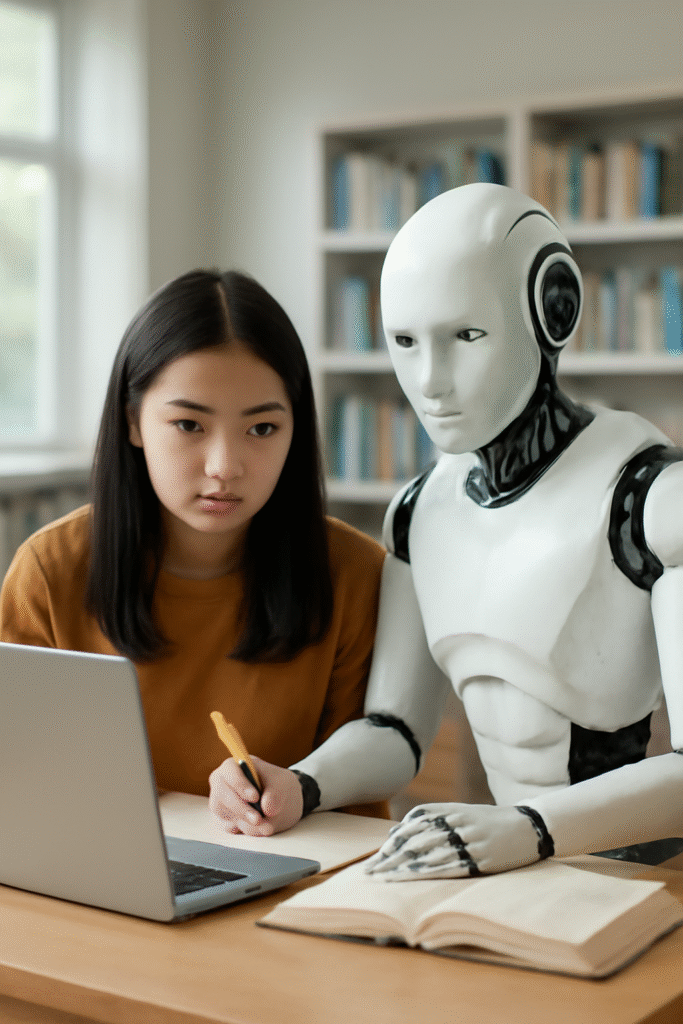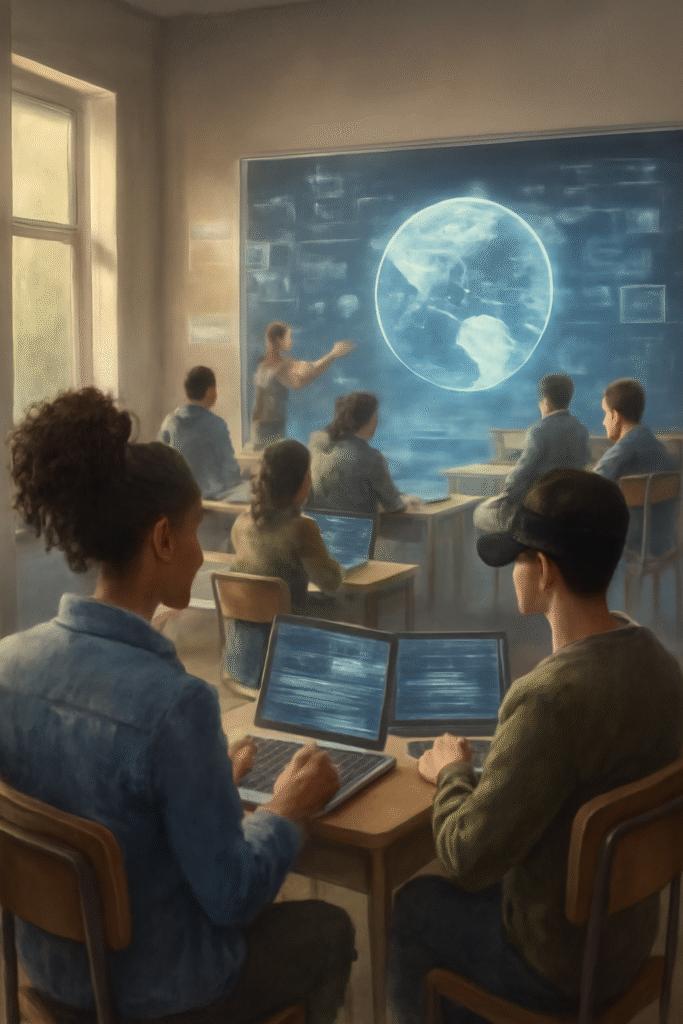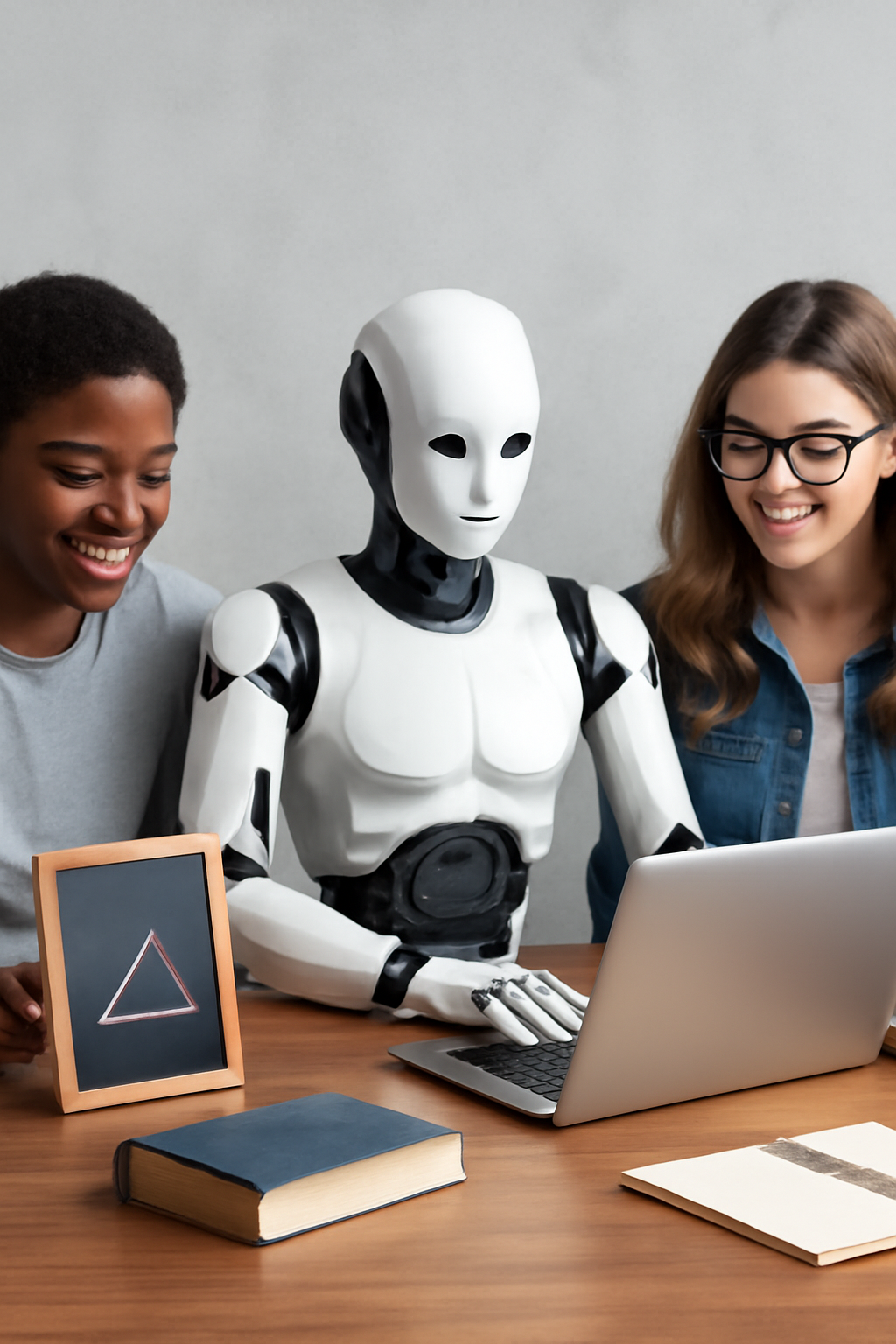✨ Uma Revolução Silenciosa
Algumas revoluções não chegam com estrondo, mas com um suave brilho azulado.
Hoje, a luz da sala de aula muitas vezes vem de uma tela — um tablet sobre a mesa, um celular na mão, uma projeção de informações infinitas condensadas em pixels.
E por trás dessa luz pulsa o novo coração da aprendizagem: a Inteligência Artificial.
A IA está remodelando a textura da educação de forma ao mesmo tempo sutil e profunda.
O aprendizado já não se limita às escolas; ele respira por redes de código e curiosidade.
Nesse cenário, as paredes da sala de aula se dissolvem; o conhecimento passa a se mover como água, fluindo para onde a atenção o conduz.
Mas esse momento pede mais do que admiração pela inovação — ele exige reflexão:
O que acontece com o sentido da educação quando uma máquina começa a nos ensinar como pensar?

I. Da Instrução à Conexão
Por séculos, a educação foi coreografia — um professor à frente, alunos voltados para o mesmo ponto, um ritmo baseado em explicação e repetição.
Ensinava obediência tanto quanto habilidade.
Mas a inteligência digital desfaz esse fluxo único e vertical.
Agora, aprender se torna diálogo, desdobrando-se entre a intuição humana e a precisão algorítmica.
Em vez de apenas transmitir fatos, plataformas de IA identificam padrões, antecipando dificuldades antes mesmo que elas se consolidem.
Um estudante que hesita diante de um problema de matemática pode acionar uma empatia digital sutil — uma dica, uma visualização, uma microaula ajustada ao seu ritmo mental.
A sala de aula se torna plural: cada aluno é visto como indivíduo e, ao mesmo tempo, como parte de uma descoberta coletiva.
A educação deixa de ser transferência de informação e passa a ser conversa de transformação.
II. A Nova Arquitetura da Curiosidade
Imagine a curiosidade como arquitetura — não feita de tijolos, mas de interações.
Cada vez que abrimos um curso online, assistimos a uma videoaula ou exploramos uma simulação, acrescentamos um novo cômodo a essa estrutura invisível.
A Inteligência Artificial agora atua como a engenheira dessa arquitetura cognitiva.
Ela observa padrões de atenção, pausas e erros — não para julgar, mas para mapear como o entendimento nasce.
Desse mapa emergem percepções antes inacessíveis aos educadores: como o cansaço afeta a compreensão, como a confiança cresce após pequenas vitórias, como a curiosidade dispara quando o aprendizado assume forma de jogo.
A IA não apenas automatiza o ensino; ela revela o próprio processo de aprender, transformando consciência em projeto.
Mas esse poder exige contenção. Um sistema que conhece tanto sobre a mente de um estudante precisa proteger a integridade — quase sagrada — dessa descoberta.
III. O Professor como Arquiteto do Sentido

Em todas as eras, a tecnologia prometeu eficiência.
Mas educação não é uma fábrica; é uma troca viva de sentido.
Quando as máquinas assumem tarefas mecânicas — corrigir provas, registrar presença, resumir conteúdos — os educadores recuperam a forma mais humana de ensinar: a presença.
Ganha-se tempo para escutar, orientar, acompanhar trajetórias e ajudar estudantes a crescer além dos números.
A IA pode mostrar ao aluno o que aprender; o professor ajuda a compreender por que aprender importa.
Uma mede a complexidade; o outro cultiva a consciência.
Juntas, constroem uma pedagogia onde inteligência e empatia coexistem.
IV. Salas de Aula que Respiram
A sala de aula do futuro talvez não tenha paredes, mas terá atmosfera — um ecossistema de sensores, dispositivos e mentes sincronizadas em torno da exploração.
Estudantes poderão caminhar por uma floresta tropical em realidade aumentada, realizando experimentos de biologia ao lado de colegas conectados de três continentes diferentes.
Idiomas se misturam, sotaques se encontram, e perspectivas culturais enriquecem o diálogo.
Esse aprendizado dissolve distâncias: uma criança da zona rural estudando astronomia pode colaborar, em tempo real, com um laboratório do outro lado do planeta.
Nessa sala de aula em rede, a igualdade não começa com ferramentas idênticas, mas com oportunidades compartilhadas.
Ensinar passa a ser conectar; aprender passa a ser pertencer.
V. Inclusão, Empoderamento e a Política do Acesso
A promessa da educação digital brilha mais forte onde a desigualdade antes projetava longas sombras.
Sistemas de tradução automática e reconhecimento de voz permitem que estudantes surdos ou com deficiência visual participem plenamente das aulas.
Texto preditivo e teclados adaptativos dão autonomia inédita a alunos com dislexia ou limitações motoras.
A conectividade, quando justa, dissolve a exclusão com mais força do que políticas isoladas.
Mas tecnologia nunca é neutra.
A mesma IA que constrói pontes pode aprofundar abismos quando a infraestrutura fica restrita a poucos.
Acesso à internet, dispositivos atualizados e formação adequada ainda são distribuídos de forma desigual.
Por isso, inclusão digital precisa ser tratada como direito, não como luxo do progresso.
Educar no século XXI é garantir que toda criança tenha a chave da mesma porta digital.
VI. A Mente Dentro dos Dados
Cada toque no teclado deixa um rastro.
As plataformas educacionais geram retratos detalhados de comportamento e cognição.
Elas percebem quando hesitamos, quanto tempo focamos, quais exemplos despertam interesse ou cansaço.
Quando governados com ética, esses dados criam o ciclo de feedback mais poderoso já visto na educação — capazes de identificar dificuldades meses antes das avaliações formais ou prevenir evasão por sinais precoces de desengajamento.
Mas sem limites, essa vigilância pode roubar a intimidade do aprender.
Nenhum estudante deve se sentir mais observado do que compreendido.
O futuro da educação dependerá não apenas da inovação, mas da virtude digital — usar o conhecimento sem invadir, medir sem reduzir a alma por trás dos números.
VII. Aprender como Experiência, não como Avaliação
Durante muito tempo, notas definiram esforço, reduzindo crescimento a dígitos.
Mas aprender é ritmo, não contagem regressiva.
A IA convida a uma transição da avaliação para a evolução.
Imagine plataformas em que o progresso aparece como uma jornada — com altos e baixos formando uma narrativa, em vez de rankings frios.
O sistema pode valorizar perseverança, criatividade e até boas perguntas, não apenas respostas corretas.
Quando a avaliação vira experiência interativa, os alunos reencontram algo que muitos adultos perderam: o prazer de perguntar.
Aprendem que inteligência não é um estoque fixo, mas o movimento contínuo entre não saber e se importar o suficiente para buscar.

VIII. Além dos algoritmos, existe a imersão
As salas de aula virtuais em breve deixarão de parecer aplicativos e passarão a se assemelhar a mundos vivos.
Estudantes poderão manipular moléculas, construir modelos arquitetônicos em 3D ou treinar procedimentos cirúrgicos em ambientes simulados, sem riscos ou consequências reais.
Isso não é escapismo — é incorporação.
Ao colocar o aluno no centro de um ambiente, e não apenas diante de uma tela, a IA devolve a fisicalidade ao aprendizado digital.
Metaversos educacionais permitirão que professores conduzam equipes em jornadas de resolução de problemas: reconstruir cidades sustentáveis, interpretar modelos climáticos ou debater dilemas éticos por meio de avatares e simulações compartilhadas.
A sala de aula se transforma em uma sociedade colaborativa, onde o entendimento é vivido — não apenas explicado.
IX. Redefinindo o Propósito: do Conhecimento à Sabedoria
Talvez a maior contribuição da IA para a educação não seja a velocidade, a precisão ou o alcance — mas a reflexão.
Ao externalizar a informação, as máquinas nos lembram do que não pode ser automatizado: empatia, interpretação, imaginação e coragem.
Se qualquer dado pode ser acessado em segundos, o valor deixa de estar em memorizar e passa a estar em conectar conhecimento com sentido.
A educação precisa evoluir de formar especialistas em repetição para cultivar arquitetos de relações — pessoas capazes de unir saber e ética, inovação e compaixão.
A sabedoria já não é apenas herdada; ela é projetada no diálogo entre humanos e suas ferramentas.
X. Aprender a Ser, e Não Apenas a Saber
O filósofo Edgar Morin escreveu que o objetivo final da educação é “aprender a viver”.
Na era da IA, essa lição se torna ainda mais essencial.
Aprender a viver hoje significa navegar por um oceano de conteúdo sem se afogar, distinguir verdade de ruído, propósito de distração.
Significa ensinar pensamento crítico como autodefesa digital e criatividade como dever cívico.
Os estudantes do século XXI não precisam de mais memória — precisam de imaginação mais sábia.
A Inteligência Artificial fornece o mapa; a inteligência humana escolhe o caminho.
E nessa escolha reside a essência da liberdade.
XI. A Ética do Cuidado e o Futuro do Ensino
Os educadores do futuro usarão dois chapéus: o de cientista e o de contador de histórias.
Interpretarão dados, mas também protegerão a humanidade.
Estruturas éticas na educação baseada em IA devem garantir transparência, consentimento e justiça.
Algoritmos precisam ser compreensíveis e auditáveis por aqueles a quem servem.
Estudantes e famílias devem saber como seus dados alimentam sistemas de avaliação.
A transparência transforma cálculo em colaboração.
Ela afirma a cada aprendiz: você não é um produto; você é um participante.
Só assim a tecnologia deixa de ser apenas eficiente e passa a ser um ecossistema de cuidado, onde cada clique, comando de voz ou rastro digital fortalece o pertencimento — e não o isolamento.
XII. O Horizonte Humano
A sala de aula do século XXI já não é um lugar fixo; é uma conversa viva entre passado e futuro.
A IA pode prever padrões, mas apenas os humanos atribuem propósito a eles.
A IA calcula o tempo de aprendizagem; os humanos medem o significado.
A IA mapeia desempenho; os humanos inspiram perseverança.
A promessa da educação digital não é a perfeição, mas a parceria — um mundo onde cada estudante combina a precisão das máquinas com a poesia da dúvida humana.
Quando as máquinas assumem a memória, somos finalmente livres para fazer o que a educação sempre deveria cultivar: encanto, empatia e coragem.
Principais insights
O valor da educação migra da memorização para a criação crítica
A IA deve ampliar a empatia do professor, não substituí-la
A ética dos dados define o sucesso de qualquer revolução educacional digital
A imersão virtual pode aprofundar conexões humanas quando guiada pelo cuidado
A verdadeira medida da aprendizagem é a capacidade de imaginar com responsabilidade.
